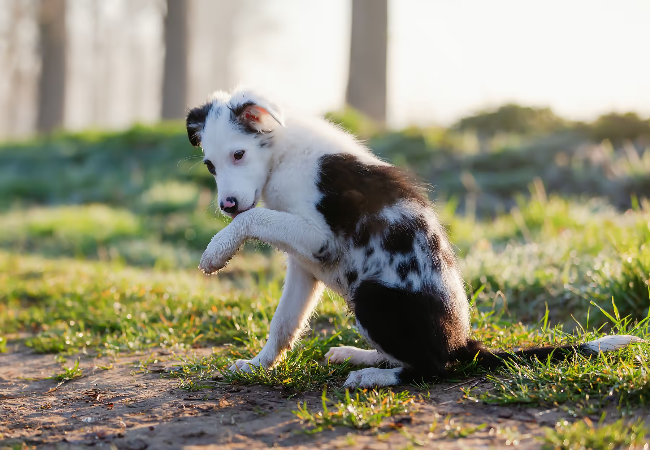Why Dogs Lick & Chew Their Paws: Causes, Care & Vet Tips for 2025 🐶🐾

In this article
Why Dogs Lick & Chew Their Paws: Causes, Care & Vet Tips for 2025 🐶🐾
By Dr. Duncan Houston BVSc
Noticed your dog sipping or nibbling on their paws? That’s common—but excessive paw licking or chewing 🍽️ might signal an underlying issue. Here’s a vet-approved, in-depth guide to understanding what’s behind this behavior in 2025. 🩺
🔍 1. When It’s Just Basic Grooming
Dogs naturally clean their paws after a walk or meal. Occasional licking—especially if both paws are involved—is usually nothing to worry about. 🧼
1️⃣ 2. Pain, Cuts & Injuries
A focused lick—especially one paw—is often a sign of injury. Think cuts, burns, stings, broken nails, or splinters. These can prompt limping, swelling, or signs of pain. A vet visit is essential if symptoms persist 🚑.
🐜 3. Parasites: Fleas, Ticks & Mites
These critters commonly hide between toes, causing itching, licking, and chewing. Regular prevention and thorough paw checks help manage infestations.
🌿 4. Allergies & Infections
Food, environmental, or contact allergies often start paw chewing and licking. Secondary yeast/bacterial infections (pododermatitis) may follow, showing redness, odor, discharge, swollen or greasy paws. Skin itch or hot spots might develop.
🦴 5. Arthritis & Joint Pain
Older dogs can have aching paw joints. Arthritis-related discomfort leads to chewing—especially in the toes. Managing arthritis can ease the behavior.
🧠 6. Stress, Boredom & OCD
Like humans biting nails, dogs lick for comfort. Anxiety, separation issues, or simple boredom can trigger obsessive paw licking (lick granuloma). Provide mental stimulation and calm care.
⚠️ 7. When It’s Time to Act
Consult a vet if there is:
- 🔥 Persistent licking/chewing
- 🤕 Limping, cries of pain
- 🩸 Bleeding, pus, redness, swelling
- 👃 Foul odor or hair loss
Unresolved issues can lead to chronic infection—early treatment ensures better outcomes.
🛠️ 8. Vet-Recommended Care & Solutions
- 🛁 Paw soaks (saline, Epsom salts) and gentle grooming
- 💊 Allergy relief—meds, prescription diet, medicated shampoos
- 🧴 Treatment for yeast/bacterial infections (topical or oral)
- 🌡️ Arthritis relief—pain meds, joint supplements, weight control
- 🧩 Boredom busters—puzzle toys, longer walks, playtime
- 🧹 Parasite prevention—tick/flea protection + paw inspection
- 🪮 Anxious dogs? Consider calming wraps, pheromone diffusers, vet-guided therapy
📅 9. Daily Paw Care Routine
- Inspect paws after outdoor time
- Clean between toes and trim nails
- Apply vet-approved balm for cracks or dryness
- Use protective booties in extreme weather
📋 Paw Licking Causes & Signs at a Glance
| Cause | Signs | Care |
|---|---|---|
| Injury | Limping, swelling, one paw | Vet exam, bandage |
| Parasites | Itching, ticks/fleas visible | Preventive meds |
| Allergy/Infection | Redness, odor, discharge | Rxs, hygiene care |
| Arthritis | Chronic licking, age-related pain | Supplements, meds |
| Behavior | Both paws, no visible issues | Stimulation, training |
📲 Ask A Vet,
Ask A Vet app connects you with vets instantly—ideal for paw-care questions and follow-ups.
🧡 Final Thoughts
Paw licking is normal when occasional, but persistent licking or chewing may signal bigger issues—from injury and infection, to allergy and anxiety. With proper checking, care, and vets involved early, most dogs recover and stay happy, healthy, and comfortable. 🐾💖






